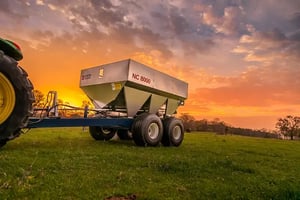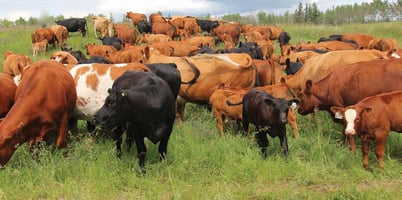Today I had to go to town to get stuff to enrich the ground. But all the spreaders of Quality Feed...
Local Production, Seasonal Consumption.
Arkansas grows rice. Washington grows apples. Iowa grows corn. Oklahoma grows cattle. On average, 5% of what we consume is grown in our state. 95% is grown in another state. As Joel Salatin would say, "Folks, this ain't normal". That is not how things should work. Imagine your local grocery store. 95% of what you buy there is from another state. Now imagine all the food you buy there that could be grown in your state. Almost everything.
I know the modern opinion about this, and have struggled with it myself. "We need centralization for efficiency and economies of sale." It is a common opinion, and makes sense if you think of nature like a machine. But it is not a machine. Half of all food in the US that is fit for human consumption never gets eaten. This is due to waste during transportation. Is it really more efficient? The average meal goes 1500 miles from field to fork, up 1400 miles from the '40s. Is it really more efficient? The obvious answer would be no.
But we still have a question, and we cannot just ignore it. Can we feed ourselves locally? Many would say no for this reason: we cannot grow everything year round. 100 years ago, that would not be a problem. It does not have to be a problem. If people would learn how to eat seasonally and preserve their food, we could have local food year round.
Minimize waste, and you maximize efficiency. Take away long transport of food, and you have twice as much consumable food in the end. Also less cost for diesel. Roughly 40 million acres of land is in lawns. What a waste. It's a shame that wasted land is more beautiful to our society than efficiently utilized land. Imagine all that lawn space was in food production.
"What about Minnesota? Where do they get their tomatoes?" Okay, here's an idea from Joel Salatin's book Folks, This Ain't Normal
Stop trucking stuff from California to the north and east. Use the money otherwise spent on diesel fuel to build high-tunnel greenhouses in colder areas. Then each state can produce its own produce.
At least for me, when I think of our current production/transport system, I do not think of a smooth, efficient system. Do you? Imagine you are an alien from outer space, watching the way our system works. You see that fish from Mexico is a staple in Baltimore. You see that a total acreage the size of Colorado is mowed for no apparent reason, wasting fuel and organic biomass. You see that half of all our food is wasted during transport. You see only a very small portion of each state's food is actually grown in that state. Do you see efficiency?
But this problem is fixable. And it is up to both producers and consumers to fix it. If producers would go for more sustainable, wiser methods of production (which by the way are also more efficient and profitable), there would actually be local good food available for consumers. Then consumers could do their part by purchasing and preserving local, unprocessed food.
So speak with your spoon. Choose true efficiency and sustainability. You make a difference, even on a small scale. You'll see it when you believe it.




